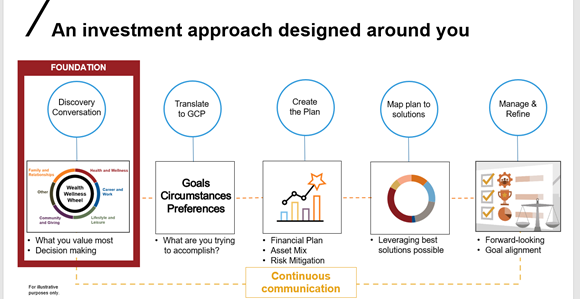The benefits of a well-planned route to financial security
I could see the other vehicle rapidly approaching me from behind. Yet there was nothing I could do. I was stuck in traffic: I couldn’t speed up, I couldn’t change lanes, I couldn’t maneuver out of the way.
Fortunately, my car was outfitted with modern safety technology and there were things it could do. The car sensed that it was about to be hit and took action: the windows and sunroof closed automatically, and the seatbelts tensed up. The car did everything it could to ensure that I got out of the impending accident safely.
The car and I braced for an impact that fortunately never came. The other vehicle missed me by less than an inch and I could feel the car shaking as it raced by.
My heart beat faster and time seemed to slow in the seconds leading up to the potential impact.
In the seconds afterward, time resumed its normal speed and my heart stopped racing. I was safe and free to continue to my destination.
I was left with two distinct feelings, one of relief for not having been in a serious accident and another of confidence in knowing that if I was ever in a similar situation again, I was in as safe a vehicle as anyone could hope to be in.
I share this story because it relates so well to the financial planning process and the boost in confidence a client can experience by working with a financial advisor.
Let’s continue with the car analogy to explain how. In doing so we will cover the benefits of a well-planned route, keeping behaviors in check and using modern investment platforms to ensure investors stay on track.
The benefits of a well-planned route
The first thing many drivers do these days before embarking on a trip is to enter their destination into a GPS or smartphone-based mapping app. Long gone are the days of getting in a car with some vague directions and finding your way to your destination. With good reason. In using mapping software, drivers can be confident knowing they are heading in the right direction and when they are likely to arrive.
As an advisor working with a client, the discovery work you do before developing a financial plan will serve much of the same purpose. In taking the time to learn your client’s goals, circumstances and preferences, you can input into your planning software where that client stands today and where they would like to go. Once that is done and the plan is generated you can issue status updates:
- Are they likely to arrive on time?
- Or will they be delayed and by how much?
For illustrative purposes only
You can even help in rerouting them should conditions change:
- New job
- Health issues
- Market volatility
You can update their financial plan and let them know how the new route will affect their arrival time (that is, reaching their financial goals). This helps in setting reasonable expectations and in relieving potential anxieties.
Keeping behaviors in check
Once the destination is in the mapping app, the driver embarks on their journey. In doing so, all sorts of choices arise. How fast should they go? Should they switch lanes to the one that seems to be moving faster?
In your role as the advisor working with a client you are in a unique position to guide them through questions like these, and others. Is your client aware of how fast they should be going, or even what the speed limit is?
After running thousands of client proposals, we have found it’s not uncommon for investors to be going the investment equivalent of either 10 or 100 miles per hour on a highway with a posted limit of 65 and not even realizing it. Based on your knowledge of the client’s goals circumstances and preferences, you can work out their required rate of return and implement an appropriate investment strategy to keep them there.
In sharing our market insights with advisors and end investors, we also find that it is easy to get distracted by perceived opportunities or returns available in concentrated areas of the markets—and to make abrupt shifts in portfolios to take advantage of them. Again, as the advisor in the relationship, you have an opportunity to remind clients these shifts can often be like changing lanes on the highway only to find the new lane has slowed, or worse yet, that there was another vehicle in their blind spot.
Click image to enlarge
Source for driver data: https://newsroom.aaa.com/2018/01/americans-willing-ride-fully-self-driving-cars/
Source for typical behavior: John R. Nofsinger, The Psychology of Investing, Pearson, 5th edition 2014.
Using modern platforms to ensure investors stay on track
This brings us back to where we started and my near miss with the other vehicle, when the windows and sunroof of my car closed automatically, and the seatbelts tensed up. The modern safety technology did things in the moment that I couldn’t or wouldn’t have done on my own, improving my odds of surviving a collision and leaving me with an increased confidence in the safety of my vehicle.
What could a modern investment platform do for you and your clients?
A modern investment platform combined with an investment strategist could help to:
- Reduce risk and improve returns through active rebalancing
- Improve consistency of returns through broad diversification across asset classes and styles
- Simplify the process of putting money to work and of taking distributions
- Manage risks and lean into opportunities through disciplined implementation of an asset allocation and active security selection
- Lower the tax drag related to investments
And potentially even more importantly, using an automated investment platform can give you and your clients time to focus on what matters most: their unique goals and the process you have developed to help them achieve those goals.
Driving a car is an inherently dangerous activity, although the risks can be mitigated. Our lives can be enriched by the speed in which they take us where we want to go. For investors embarking on a journey toward improved financial security and achieving their unique goals, being invested in the markets can feel just as dangerous. But it doesn’t need to be that way. According to a 2019 planning and progress poll,1 66% of investors working with an advisor feel very financially secure compared to 31% who are not working with an advisor. This means financial advisors are in a unique position to help their clients both plan for success and gain the confidence to achieve it.


